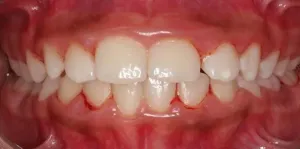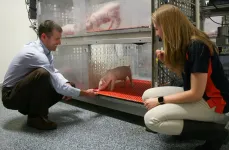(Press-News.org) By Luciana Constantino | Agência FAPESP – Adults with periodontitis transmit bacteria that can cause the disease in future to their children, and the bacteria remain in the oral cavity even when the children undergo treatment of various kinds, reinforcing the need for preventive care in the first year of a baby’s life. This is the main conclusion of a study conducted at the University of Campinas (UNICAMP) in the state of São Paulo, Brazil. An article on the study is published in Scientific Reports.
Periodontitis is an inflammation of the periodontium, the tissue that supports the teeth and maintains them in the maxillary and mandibular bones. The disease is triggered by bacterial infection. Symptoms include bleeding of the gums and halitosis. In severe cases, it leads to bone and tooth loss. If the bacteria or other microorganisms that cause the disease enter the bloodstream, they may trigger other kinds of inflammation in the body. Treatment includes cleaning of the pockets around teeth by a dentist or hygienist and administration of anti-inflammatory drugs or antibiotics.
“The parents’ oral microbiome is a determinant of the subgingival microbial colonization of their children,” the article’s authors state in their conclusions, adding that “dysbiotic microbiota acquired by children of periodontitis patients at an early age are resilient to shift and the community structure is maintained even after controlling the hygiene status”.
According to dental surgeon Mabelle de Freitas Monteiro, first author of the article, she and her group have been researching periodontitis for ten years, observing parents with the disease and its impact on their children’s health.
“If the findings are applied to day-to-day dental practice, the study can be said to help design more direct approaches. Knowing that periodontal disease may affect the patient’s family is an incentive to use preventive treatment, seek early diagnosis and mitigate complications,” said Monteiro, who was supported by FAPESP via two projects (16/03704-7 and 16/19970-8).
The principal investigator for both projects was Renato Corrêa Viana Casarin, a professor at UNICAMP’s Piracicaba Dental School (FOP) and last author of the article.
For Casarin, parents should start caring for the health of their children’s gums when they are infants. “This pioneering study compares parents with and without periodontitis. In children of the former, we found subgingival bacterial colonization at a very early age. However, ‘inheriting’ the problem doesn’t mean a child is fated to develop the disease in adulthood. Hence the importance of keeping an eye open for the smallest signs and seeking specialized help,” Casarin said.
Data on the Brazilian population’s oral health is scarce. According to the last national dental epidemiological survey, conducted by the Ministry of Health in 2010, 18% of children aged 12 had never been to the dentist and 11.7% had experienced bleeding of the gums. In the 15-19 age group, 13.6% had never visited a dental clinic. Another survey was scheduled for 2020 but had to be postponed because of the COVID-19 pandemic.
The São Paulo State Department of Health published the findings of its latest oral health survey in 2019, showing among other things that 50.5% of adults aged 35-44 complained of toothache, bleeding gums and periodontitis (read more at: agencia.fapesp.br/30260/).
Bacteria
In the FOP-UNICAMP study led by Casarin and Monteiro, samples of subgingival biofilm and plaque were collected from 18 adults with a history of generalized aggressive (grade C) periodontitis, their children aged 6-12, and 18 orally healthy adults.
In addition to a clinical analysis, the samples were also subjected to a microbiological analysis and genetic sequencing by researchers at Ohio State University in the United States under the supervision of Professor Purnima Kumar.
“Children of periodontitis parents were preferentially colonized by Filifactor alocis, Porphyromonas gingivalis, Aggregatibacter actinomycetemcomitans, Streptococcus parasanguinis, Fusobacterium nucleatum and several species belonging to the genus Selenomonas even in the absence of periodontitis,” the article states. “These pathogens also emerged as robust discriminators of the microbial signatures of children of parents with periodontitis.”
Casarin told Agência FAPESP that despite bacterial plaque control and vigorous brushing the children of people with the disease still had the bacteria in their mouths, whereas the effects of dental hygiene and prophylaxis were more significant in the children of healthy subjects.
“Because the parents had periodontitis, their children assumed this community with disease characteristics. They carried the bacterial information into their adult lives,” he said, adding that the analysis of bacterial colonization pointed to a greater likelihood of transmission by the mother. The research group will now work with pregnant women in an effort to “break the cycle” by preventing bacterial colonization of their children’s mouths.
“We’ll treat the mothers during pregnancy, before the babies are born, and try to find out if it’s possible to prevent bacterial colonization from occurring,” Casarin said, noting that studies with patients will proceed only when control of the pandemic permits.
Recognition
The periodontitis research group led by Casarin has won prizes at home and abroad. In 2019, Monteiro topped the clinical research category of the IADR’s Hatton Competition. The IADR (International Association for Dental Research) hosts the world’s leading conference on dentistry, and the competition is designed to provide an opportunity for the best junior investigators to present their research (read more in Portuguese at: www.fop.unicamp.br/index.php/pt-br/doi-odontopediatria/2352.html).
Years earlier the group won an award from the American Academy of Periodontology for the study with the most significant clinical impact.
The article “Parents with periodontitis impact the subgingival colonization of their offspring” is at: www.nature.com/articles/s41598-020-80372-4.
Bacteria that cause periodontitis are transmitted from parents to children
A study led by researchers at the University of Campinas reinforces the need for prevention and follow-up treatment starting in early childhood to avoid development of this inflammatory disease of the gums.
2021-04-14
ELSE PRESS RELEASES FROM THIS DATE:
Finally, 3D-printed graphene aerogels for water treatment
2021-04-14
BUFFALO, N.Y. -- Graphene excels at removing contaminants from water, but it's not yet a commercially viable use of the wonder material.
That could be changing.
In a recent study, University at Buffalo engineers report a new process of 3D printing graphene aerogels that they say overcomes two key hurdles -- scalability and creating a version of the material that's stable enough for repeated use -- for water treatment.
"The goal is to safely remove contaminants from water without releasing any problematic chemical residue," says study co-author Nirupam Aich, PhD, assistant professor of environmental engineering at the UB School of Engineering and Applied Sciences. "The aerogels ...
Adults who view TV and social media as news sources on COVID are less informed
2021-04-14
HERSHEY, Pa. -- People who trust television and Facebook to provide them with accurate news about the coronavirus pandemic are less knowledgeable about COVID-19, according to a new study, which assessed people's knowledge of the virus in the earliest stages of the pandemic.
The study, published in the peer-reviewed journal Current Medical Research & Opinion, surveyed 5,948 adults in Pennsylvania between March 25-31, 2020, and found that those who relied on social media and TV for news were less likely to get the facts right about the coronavirus.
In fact, adults that used Facebook as an additional ...
In pig brain development, nature beats nurture
2021-04-14
URBANA, Ill. - Before humans can benefit from new drug therapies and nutritional additives, scientists test their safety and efficacy in animals, typically mice and rats. But, as much as they've done for biomedical research, rodents aren't always the best research model for studies on neonatal brain development and nutrition. That's where pigs can play an important role.
University of Illinois researchers say the domestic pig is ideal for these studies because their brain size, rate of development, and digestive system are excellent analogues for human newborns.
They know a lot about pig brains, having built the first - and recently, the second - complete, MRI-based atlases of the organ. They've used the first to study ...
Shape-shifting Ebola virus protein exploits human RNA to change shape
2021-04-14
La Jolla, CA--The human genome contains the instructions to make tens of thousands of proteins. Each protein folds into a precise shape--and biologists are taught that defined shape dictates the protein's destined function. Tens of thousands of singular shapes drive the tens of thousands of needed functions.
In a new Cell Reports study, researchers at La Jolla Institute for Immunology demonstrate how Ebola virus has found a different way to get things done. The virus encodes only eight proteins but requires dozens of functions in its lifecycle. ...
The American public is responsible for identifying over a quarter of new invasive species
2021-04-14
New research by a team at Resources for the Future (RFF) has found that at least 27% of new pests in the United States were initially detected by members of the general public. The study, which was published today in the journal Conservation Science and Practice, seeks to understand who is identifying new invasive species that make their way into the United States.
The RFF team developed and analyzed a new dataset of pest discoveries in the United States, using a sample size of 169 detections from 2010 to 2018. Researchers divided discovery sources into three categories: government agencies, local extension specialists and researchers, and members of the public, with the latter category including community ...
Social wasps lose face recognition abilities in isolation
2021-04-14
ITHACA, N.Y. - Just as humans are challenged from the social isolation caused by the coronavirus pandemic, a new study finds that a solitary lifestyle has profound effects on the brains of a social insect: paper wasps.
Paper wasps recognize the brightly colored faces of other paper wasps, an ability they lose when reared in isolation. The wasps' ability to remember faces is similar to primates and humans, but unlike other social insects.
The study revealed that when adult wasps are housed in solitude, visual areas of their brains - especially those involved with identifying nuanced color patterns and shapes - are smaller and less developed ...
HSE University researchers track language abilities of russian children with ASD
2021-04-14
Researchers from the HSE Center for Language and Brain https://www.hse.ru/en/neuroling/ have, for the first time, described the language abilities of Russian children with Autism Spectrum Disorder (ASD) at all linguistic levels (e.g., phonology, lexicon, morphosyntax, and discourse), using a language test that takes into account the psycholinguistic variables most relevant for Russians. The study was published in Journal of Autism and Developmental Disorders.
In 2020, the US Centers for Disease Control and Prevention reported that one in every 54 children in the country is diagnosed with ASD. Usually, ...
Fast-spinning black holes narrow the search for dark matter particles
2021-04-14
Ultralight bosons are hypothetical particles whose mass is predicted to be less than a billionth the mass of an electron. They interact relatively little with their surroundings and have thus far eluded searches to confirm their existence. If they exist, ultralight bosons such as axions would likely be a form of dark matter, the mysterious, invisible stuff that makes up 85 percent of the matter in the universe.
Now, physicists at MIT's LIGO Laboratory have searched for ultralight bosons using black holes -- objects that are mind-bending orders of magnitude ...
Gigantic flying pterosaurs had spoked vertebrae to support their 'ridiculously long' necks
2021-04-14
Little is known about azhdarchid pterosaurs, gigantic flying reptiles with impressive wingspans of up to 12 meters. Cousins of dinosaurs and the largest animals ever to fly, they first appeared in the fossil record in the Late Triassic about 225 million years ago and disappeared again at the end of the Cretaceous period about 66 million years ago. One of their most notable features for such a large flighted animal was a neck longer than that of a giraffe. Now, researchers report an unexpected discovery in the journal iScience on April 14: their thin neck vertebrae got their strength from an intricate internal structure unlike anything ...
Genetic admixture in the South Pacific: from Denisovans to the human immune response
2021-04-14
Describing the genetic diversity of human populations is essential to improve our understanding of human diseases and their geographical distribution. However, the vast majority of genetic studies have been focused on populations of European ancestry, which represent only 16% of the global population. Scientists at the Institut Pasteur, Collège de France, and CNRS have looked at understudied human populations from the South Pacific, which are severely affected by a variety of diseases, including vector-borne infectious diseases such as Zika virus, dengue, and chikungunya, and metabolic diseases such as obesity and diabetes. Using genome sequencing of ...
LAST 30 PRESS RELEASES:
Eye for trouble: Automated counting for chromosome issues under the microscope
The vast majority of US rivers lack any protections from human activities, new research finds
Ultrasound-responsive in situ antigen "nanocatchers" open a new paradigm for personalized tumor immunotherapy
Environmental “superbugs” in our rivers and soils: new one health review warns of growing antimicrobial resistance crisis
Triple threat in greenhouse farming: how heavy metals, microplastics, and antibiotic resistance genes unite to challenge sustainable food production
Earthworms turn manure into a powerful tool against antibiotic resistance
AI turns water into an early warning network for hidden biological pollutants
Hidden hotspots on “green” plastics: biodegradable and conventional plastics shape very different antibiotic resistance risks in river microbiomes
Engineered biochar enzyme system clears toxic phenolic acids and restores pepper seed germination in continuous cropping soils
Retail therapy fail? Online shopping linked to stress, says study
How well-meaning allies can increase stress for marginalized people
Commercially viable biomanufacturing: designer yeast turns sugar into lucrative chemical 3-HP
Control valve discovered in gut’s plumbing system
George Mason University leads phase 2 clinical trial for pill to help maintain weight loss after GLP-1s
Hop to it: research from Shedd Aquarium tracks conch movement to set new conservation guidance
Weight loss drugs and bariatric surgery improve the body’s fat ‘balance:’ study
The Age of Fishes began with mass death
TB harnesses part of immune defense system to cause infection
Important new source of oxidation in the atmosphere found
A tug-of-war explains a decades-old question about how bacteria swim
Strengthened immune defense against cancer
Engineering the development of the pancreas
The Journal of Nuclear Medicine ahead-of-print tip sheet: Jan. 9, 2026
Mount Sinai researchers help create largest immune cell atlas of bone marrow in multiple myeloma patients
Why it is so hard to get started on an unpleasant task: Scientists identify a “motivation brake”
Body composition changes after bariatric surgery or treatment with GLP-1 receptor agonists
Targeted regulation of abortion providers laws and pregnancies conceived through fertility treatment
Press registration is now open for the 2026 ACMG Annual Clinical Genetics Meeting
Understanding sex-based differences and the role of bone morphogenetic protein signaling in Alzheimer’s disease
Breakthrough in thin-film electrolytes pushes solid oxide fuel cells forward
[Press-News.org] Bacteria that cause periodontitis are transmitted from parents to childrenA study led by researchers at the University of Campinas reinforces the need for prevention and follow-up treatment starting in early childhood to avoid development of this inflammatory disease of the gums.




